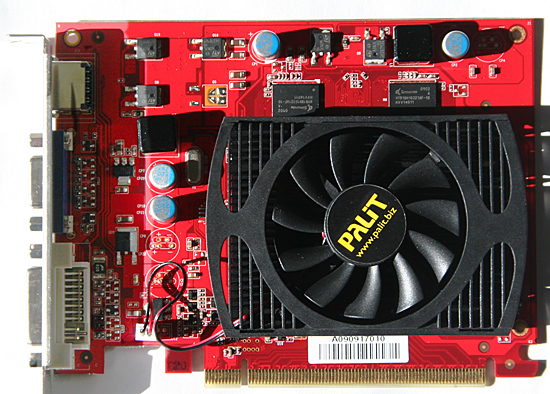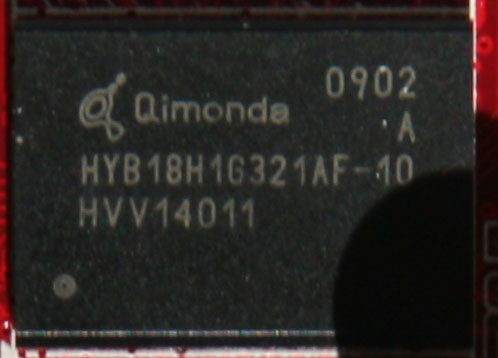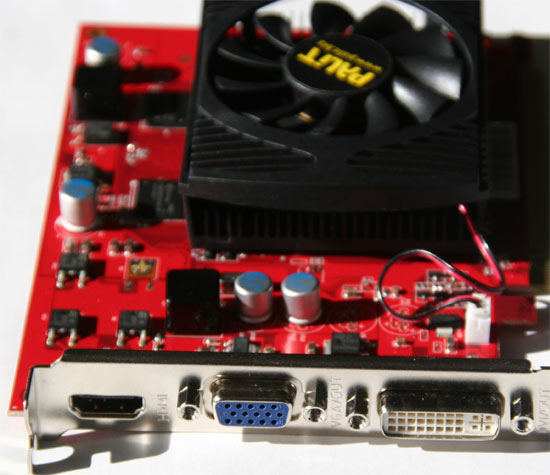NVIDIA’s GeForce GT 220: 40nm and DX10.1 for the Low-End
by Ryan Smith on October 12, 2009 6:00 AM EST- Posted in
- GPUs
Palit’s GT 220 Sonic Edition
As we mentioned in our introduction, for today’s launch we have a GT 220 graciously provided by Palit, in the form of their $79 GT 220 Sonic Edition. This card is ever so slightly factory overclocked, coming in at 650MHz for the core (a 4% overclock), a standard 1360MHz for the shaders, and 900MHz for its GDDR3 memory. As this is a GDDR3 card, it comes with 512MB of RAM.

As far as we know, this is as close to a reference cooler as you’re going to see for the GT 220, as we’ve seen this cooler on a couple other product brochures. It’s a rectangular single-slot height heatsink, with a fan mounted above it. This makes the entirety of the cooler wider than a single slot, and in practice this is a dual-slot card even if it’s not officially classified as such. The fan used is a simple two pin fan, so it blows at a fixed rate.

The 4 memory chips on this card are Qimonda HYB18H1G321AF-10. We haven’t been able to find the precise specs for that specific memory chip, but we believe it’s rated for 1000MHz, 100MHz over the operating speed of the card. We’re somewhat curious where Palit is getting these chips though, since Qimonda ceased production 6 months ago amidst bankruptcy. Apparently there’s a stockpile of these things somewhere.
Since it’s a low-power card, the overall design of the GT 220 Sonic Edition is rather simple compared to the complex beasts we see on the high-end. Nothing except the GT216 core itself is cooled, and we know that Palit is using solid OS-CON capacitors.

The port layout for this card is 1 HDMI port, 1 VGA port, and 1 DVI port, which appears to be the standard for the GT 220. With one of each port type, Palit’s GT220 Sonic Edition does not come with any port dongles. For that matter, the only other thing you’ll find in the box is a basic manual and driver CD (190.45).
| Form Factor | GT 220 Sonic 512MB | GT 220 1GB DDR3 | GT 220 1GB DDR2 | GT 220 512MB DDR2 |
| Stream Processors | 48 | 48 | 48 | 48 |
| Texture Address / Filtering | 16 / 16 | 16 / 16 | 16 / 16 | 16 / 16 |
| ROPs | 8 | 8 | 8 | 8 |
| Core Clock | 650MHz | 635MHz | 635MHz | 635MHz |
| Shader Clock | 1360MHz | 1360MHz | 1360MHz | 1360MHz |
| Memory Clock | 900MHz | 790MHz | 400MHz |
400MHz |
| Memory Bus Width | 128-bit | 128-bit | 128-bit | 128-bit |
| Frame Buffer | 512MB | 1GB | 1GB | 512MB |
| Transistor Count | 486M | 486M | 486M | 486M |
| Manufacturing Process | TSMC 40nm | TSMC 40nm | TSMC 40nm | TSMC 40nm |
| Price Point | $79 | ? | ? | ? |
Palit will be releasing three other GT 220 cards, in the other configurations that NVIDIA is allowing. These will be two DDR2-equiped cards with 512MB or 1GB of memory running at 400MHz, and a 1GB DDR3 card with its memory running at 790MHz. We don’t have these other cards on-hand, but based on the performance data supplied by Palit, the DDR3 card should be within 10% of the Sonic Edition, and the DDR2 card will be around 60% the speed.
Finally, Palit’s cards should be available from Newegg starting on Tuesday. Palit retreated from the North American market earlier this year to reorganize, so this marks the resumption of their North American retail sales.










80 Comments
View All Comments
Ryan Smith - Monday, October 12, 2009 - link
I don't have that information at this moment. However this is very much the wrong card if you're going scientific work for performance reasons.apple3feet - Wednesday, October 14, 2009 - link
Well, as a developer, I just need it to work. Other machines here have TESLAs and GTX280s, but a low end cool running card would be very useful for development machines.I believe that the answer to my question is that it's 1.2 (i.e. everything except double precision), so no good for me.
jma - Monday, October 12, 2009 - link
Ryan, if you run 'deviceQuery' from the Cuda SDK, it will tell you all there is to know.Another goodie would be 'bandwidthTest' for those of us who can't figure out the differences between various DDR and GDDR's and what the quoted clocks are supposed to imply ...
vlado08 - Monday, October 12, 2009 - link
My HD 4670 idles in 165MHz core and 249,8MHz memoy clock and GPU temps 36-45 degrees(passively cooled) as reported by GPU-Z 0.3.5 Is there a possibility that your card didn't lower it's clock during idle?vlado08 - Monday, October 12, 2009 - link
My question is to Ryian of course.Ryan Smith - Monday, October 12, 2009 - link
Yes, it was idling correctly.KaarlisK - Monday, October 12, 2009 - link
The HD4670 cards differ.I've bought three:
http://www.asus.com/product.aspx?P_ID=Z9qnCFnOUNDM...">http://www.asus.com/product.aspx?P_ID=Z9qnCFnOUNDM...
http://www.gigabyte.com.tw/Products/VGA/Products_O...">http://www.gigabyte.com.tw/Products/VGA/Products_O...
http://www.asus.com/product.aspx?P_ID=g6LDXHUo0EzV...">http://www.asus.com/product.aspx?P_ID=g6LDXHUo0EzV...
The first one would idle at 0.9v.
The second would idle at 1.1v. When I edited the BIOS for lover idle voltages, I could not get it to be stable.
The third one turned out to have a much cheaper design - not only did it have slower memory, it had no voltage adjustments and idles at 1.25v (but the correct idle frequency).
vlado08 - Monday, October 12, 2009 - link
Are GT 220 capable of DXVA decoding of h.264 at High Profile Level 5.1?And videos wiht more than 5 reference frames. Because ATI HD4670 can only do High Profile (HiP) Level 4.1 Blu-ray compatible.
Also what is the deinterlacing on GT 220 if you have monitor and TV in extended mode? Is it vector adaptive deinterlacing?
These questions are important for this video card because it is obvious that it is not for gamer but for HTPC.
On HD 4670 when you have one monitor then you have vector adaptive deinterlacing but if you have two monitors or monitor and TV and they are in extended mode then you only have "bob" deinterlacing.
I'm not sure if this is driver bug or hardware limitation.
Ryan Smith - Monday, October 12, 2009 - link
I have another GT 220 card due this week or early next. Drop me an email; if you have something I can use to test it, I will gladly try it out. I have yet to encounter anything above 4.1 though; it seems largely academic.MadMan007 - Monday, October 12, 2009 - link
So my inner nerd that just has to know is confused. Are these truly GT200-based or G9x-based? Different sources say different things. In a way the GT200 series was an improvement on G9x anyway but with enough significant low level changes to make it different. The article calls these GT200 *series* but that could be in name only. It's not clear if that means smaller process cut down die GT200-based or added feature G9x-based.Inquiring nerds want to know!